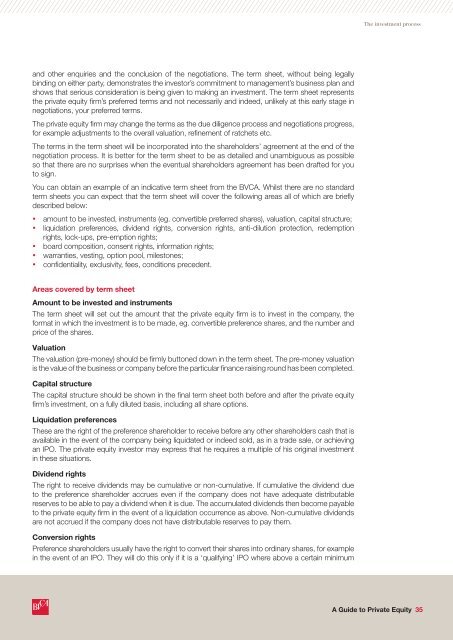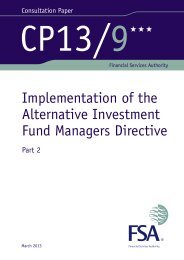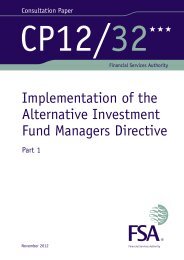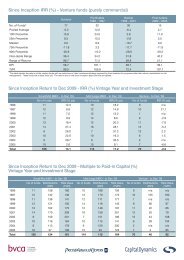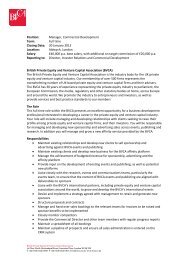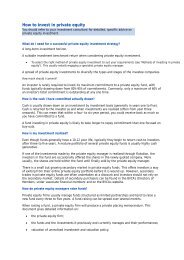A Guide to Private Equity - BVCA admin
A Guide to Private Equity - BVCA admin
A Guide to Private Equity - BVCA admin
You also want an ePaper? Increase the reach of your titles
YUMPU automatically turns print PDFs into web optimized ePapers that Google loves.
and other enquiries and the conclusion of the negotiations. The term sheet, without being legally<br />
binding on either party, demonstrates the inves<strong>to</strong>r’s commitment <strong>to</strong> management’s business plan and<br />
shows that serious consideration is being given <strong>to</strong> making an investment. The term sheet represents<br />
the private equity firm’s preferred terms and not necessarily and indeed, unlikely at this early stage in<br />
negotiations, your preferred terms.<br />
The private equity firm may change the terms as the due diligence process and negotiations progress,<br />
for example adjustments <strong>to</strong> the overall valuation, refinement of ratchets etc.<br />
The terms in the term sheet will be incorporated in<strong>to</strong> the shareholders’ agreement at the end of the<br />
negotiation process. It is better for the term sheet <strong>to</strong> be as detailed and unambiguous as possible<br />
so that there are no surprises when the eventual shareholders agreement has been drafted for you<br />
<strong>to</strong> sign.<br />
You can obtain an example of an indicative term sheet from the <strong>BVCA</strong>. Whilst there are no standard<br />
term sheets you can expect that the term sheet will cover the following areas all of which are briefly<br />
described below:<br />
• amount <strong>to</strong> be invested, instruments (eg. convertible preferred shares), valuation, capital structure;<br />
• liquidation preferences, dividend rights, conversion rights, anti-dilution protection, redemption<br />
rights, lock-ups, pre-emption rights;<br />
• board composition, consent rights, information rights;<br />
• warranties, vesting, option pool, miles<strong>to</strong>nes;<br />
• confidentiality, exclusivity, fees, conditions precedent.<br />
Areas covered by term sheet<br />
Amount <strong>to</strong> be invested and instruments<br />
The term sheet will set out the amount that the private equity firm is <strong>to</strong> invest in the company, the<br />
format in which the investment is <strong>to</strong> be made, eg. convertible preference shares, and the number and<br />
price of the shares.<br />
Valuation<br />
The valuation (pre-money) should be firmly but<strong>to</strong>ned down in the term sheet. The pre-money valuation<br />
is the value of the business or company before the particular finance raising round has been completed.<br />
Capital structure<br />
The capital structure should be shown in the final term sheet both before and after the private equity<br />
firm’s investment, on a fully diluted basis, including all share options.<br />
Liquidation preferences<br />
These are the right of the preference shareholder <strong>to</strong> receive before any other shareholders cash that is<br />
available in the event of the company being liquidated or indeed sold, as in a trade sale, or achieving<br />
an IPO. The private equity inves<strong>to</strong>r may express that he requires a multiple of his original investment<br />
in these situations.<br />
Dividend rights<br />
The right <strong>to</strong> receive dividends may be cumulative or non-cumulative. If cumulative the dividend due<br />
<strong>to</strong> the preference shareholder accrues even if the company does not have adequate distributable<br />
reserves <strong>to</strong> be able <strong>to</strong> pay a dividend when it is due. The accumulated dividends then become payable<br />
<strong>to</strong> the private equity firm in the event of a liquidation occurrence as above. Non-cumulative dividends<br />
are not accrued if the company does not have distributable reserves <strong>to</strong> pay them.<br />
Conversion rights<br />
Preference shareholders usually have the right <strong>to</strong> convert their shares in<strong>to</strong> ordinary shares, for example<br />
in the event of an IPO. They will do this only if it is a ‘qualifying’ IPO where above a certain minimum<br />
The investment process<br />
A <strong>Guide</strong> <strong>to</strong> <strong>Private</strong> <strong>Equity</strong> 35


